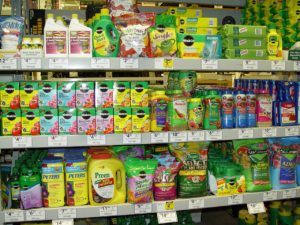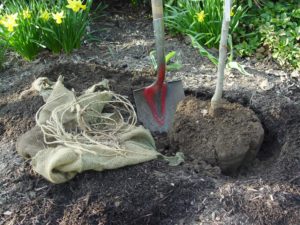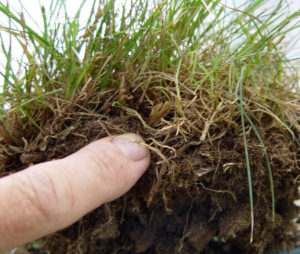Top 10 Myths about Gardening
December 6th, 2016
So you think you know yard care, eh?
Below are 10 gardening beliefs that people think are true but that are really myths. See how many you thought were true…
Myth 1.) A little fertilizer is good. More is even better.
Wrong. You’re wasting money by putting down more fertilizer than a plant needs or is going to use. Worse yet, excess fertilizer can burn plant roots, mess with your soil’s nutrient balance, make plants more attractive to bugs and needlessly pollute.
Add only what nutrients your soil and plants need. The best way to determine that is by doing a mail-in, Penn State soil test, available for $9-$10 at county Extension offices, most garden centers, or online at Penn State’s soil test lab.
The report will tell you what you’re lacking and exactly how much of which nutrients you should add (if any). Otherwise, you’re just guessing.
Myth 2.) A little mulch is good. More is even better.
Two to three inches of wood or bark mulch is plenty around trees and shrubs. One to two inches is enough around flowers. Don’t keep adding more each year if you already have that much.
Excess mulch deprives plant roots of oxygen and stunts growth – even to the point of killing plants. It also takes a lot of rain to get through all of that mulch and down to the plant roots where it’s really needed.
And please don’t pack mulch up against tree trunks (known as “mulch volcanoes”). That can rot the bark and kill trees.
Myth 3.) Bug-killers, fungicides and weed-killers work better when you mix them extra strong.
Those dosage labels are there for a reason. If you follow directions, the product should work as intended. (See my article on “Top 10 Reasons Why You Really Should Read the Pesticide Label.”)
You’re not only technically violating federal law by flaunting label rules, but there’s a good chance you’ll needlessly pollute, increase your own handling risk, and maybe even burn or kill your plants from using too-strong of a dose.
I’ve found that when products don’t work, it’s usually not because the dose is too weak but because people are using the wrong product for the wrong problem or applying it at the wrong time (i.e. after a bug has moved on or after a disease is already in full swing).
Myth 4.) Bugs spread fast, so it’s best to spray everything regularly, just in case.
Bad idea, especially long-term. Besides the unnecessary expense and pollution, when you spray, you kill the good with the bad. And since the bad guys recover faster, you’ve called off the “posse” and set yourself up for ongoing spraying.
A better idea: First identify a problem, then determine if action is needed, then seek the most targeted treatment at the right time, if treatment is warranted.
Encouraging natural predators and good plant selection are better options for dealing with garden bugs.
Myth 5.) Plant a tree deeply so it’ll be less likely to blow over.
That’s actually one of the best ways to kill a tree. Too-deep roots can die from lack of oxygen, but a bigger problem is that bark will rot when the trunk is underground. Roots are meant to be buried, not trunks.
Plant so the “root flare” (where the base of the trunk gets wider as it transitions into the roots) is just above ground level.
Myth 6.) Organic products are safer than chemicals.
It’s not that simple. Just because a product comes from a plant or other “natural” source doesn’t mean it’s harmless to people, pets, bees, fish, groundwater, beneficial insects, etc.
Different concoctions carry different levels and kinds of risks, whether nature creates them or a chemist does. The plant-based bug-killer rotenone, for example, is far more toxic if ingested than Roundup weed-killer.
The more accurate way to assess risk is by reading the labels and researching safety on a product-by-product basis. One resource I like: the university-run Extension Toxicology Network.
Myth 7.) Native plants don’t get bugs and disease.
Don’t we wish. Plenty of bugs and diseases attack both native and non-native plants.
The difference is that natives typically have evolved to survive the damage.
In other words, natives aren’t immune to damage. However, much of the chewing damage and ratty leaves you might see on native plants is temporary and/or cosmetic, and in some cases is being done by “friendly” bugs (i.e. predators or caterpillars that will morph into butterflies).
Myth 8.) You should till the soil every year.
This once was regarded as a must for vegetable gardens. After all, farmers tilled every year. But now, tilling is considered to be counter-productive.
For one thing, it stirs up weed seeds. For another, it’s harmful to earthworms (soil’s No. 1 helper). And it may even destroy soil texture by pulverizing soil particles or by compacting them if you till when the soil’s wet.
You still may need to till once when converting turfgrass into a garden, but after that, just layer compost on the top of beds each fall – similar to what nature does with falling leaves.
Myth 9.) Grass clippings cause thatch.
Thatch, that spongy layer between grass blades and grass roots, is harmless in small amounts, but when it builds up to more than an inch, it hinders rain and nutrients from working into the roots.
Thatch once was thought to be composed mostly of grass clippings, which led to widespread bagging and disposal of the clips. However, thatch is really mostly dead surface roots that aren’t decaying as fast as they should – usually due to excess pesticide use, shallow watering and over-fertilization.
Decaying grass clips actually return organic matter and nutrients to the lawn soil.
Myth 10.) Tree cuts should be coated with tar or paint after branches are pruned.
Trees heal best when they’re cut just outside the little raised ring where a branch attaches to a trunk. Just let the air dry the wound, and otherwise healthy trees will take it from there.
Research has found that coating wounds can trap moisture that actually encourages rot in the wood beneath it.
One thing you can do is clean-cut any broken, ragged limbs back to the ring. And when you prune, look for that ring and don’t let stubs and don’t gouge into the trunk.
Since trees heal better from the loss of smaller limbs than bigger ones, it’s also helpful to prune excess or unwanted branches sooner rather than later.










